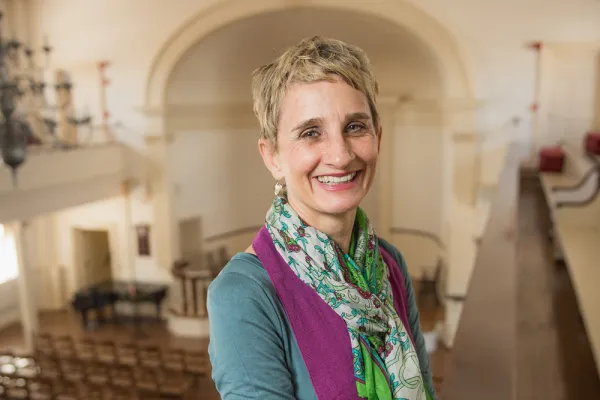Building Community Through ‘Justice and Joy’
Campus Life

Published April 6, 2021
Smith is a community that finds strength in gathering. In the wake of George Floyd’s death last year, many members of the campus community went searching for ways to come together.
One result was Generating Justice and Joy, a pilot program of the Center for Religious and Spiritual Life that offers students, faculty and staff an ongoing way to build community in the midst of challenging times.
“Part of our role at the Center for Religious and Spiritual Life is to help one another make meaning of things,” says center director Matilda Cantwell. “We were looking for a new way we could come together that would let us be proactive instead of reactive—a place to connect and acknowledge the ongoing crises as an act of resistance; refusing to accept these things as commonplace.”
Since it began last summer, Generating Justice and Joy has sponsored virtual gatherings around themes including racial justice, welcoming each other to a new semester and commemorating a year of the pandemic.
The sessions—designed in partnership with the Jandon Center for Community Engagement, the Office of Equity and Inclusion, Multicultural Affairs, and the Schacht Center for Health and Wellness, among others—include mindfulness, music and space for sharing both “joys and concerns,” Cantwell says.
Another gathering, “Generating Justice and Joy: An On-Campus COVID Memorial,” invited community members to meet on the lawn of Smith’s boathouse. They shared and remembered loved ones they have lost over the course of the past year, and to mark “dreams deferred” during this time of disruption.
The outdoor space was chosen because of the special meaning of Paradise Pond to the Smith community. The project is a collaboration with Andy Rotman, professor of religion, Buddhist studies and South Asian studies, as well as staff from the Smith Botanic Garden and Design Thinking Initiative.
Here’s what Cantwell had to say about Generating Justice and Joy:
Where did the idea for this new program come from?
“In the back of our minds were questions about what makes a community and how a gathering helps that community to coalesce. Last May came, and we were off campus when George Floyd was killed. And we found ourselves trying to figure out what to do—would we respond as if to a single incident or to a larger trend? We came up with the idea for a program that incorporates the idea of a vigil with having a regular space where people can bring in whatever is on their mind.”
What does the title of the program signify?
“The idea is that by coming together, we are going to be generating justice. As a small liberal arts college, our gathering traditions are paramount to our identity. As a women’s college, our community and empowering one another are very much a part of who we are. Similar to a vigil, we wanted these sessions to be separate [from daily activities] and have a participatory, ritual element. Participants will encounter not just one thing; we mourn, but we also celebrate. That’s the joy part of it.”
Can you describe what the March 18 event about commemorating a year of COVID was like?
“We had the honor of hearing from staff and faculty leaders across campus, including President McCartney, who spoke candidly and beautifully about her own experience of loss. We also noted the ways that societal inequities make loss so much more prevalent in some communities than others, and recommitted to the work of justice, which is so much a part of our aspirations as an institution.”
What has it been like to hold gatherings virtually?
“It’s been more successful than I would have expected. Our first forum in the wake of George Floyd was done as a Zoom Webinar, and we couldn’t see the people who were attending. For the next one, we were able to see people’s faces, even in those small Zoom squares—which felt better. Using the breakout room function also creates an immediate intimacy. I do hope those sessions have been inspiring and comforting to people.”
What do you hope the impact of this new program will be?
“We are a very diverse community—in our curriculum, our house communities, our faculty. We have a need to gather, but also a lot of things that make community challenging. What I envision is that Smith community members will want to come together to be proactive and connect even when there is not a crisis. My long-term vision would be robust gatherings where people show up together to share joys and concerns. We want to build programs where we can be positive actors; where we can look at each other and see who we are as a community.”